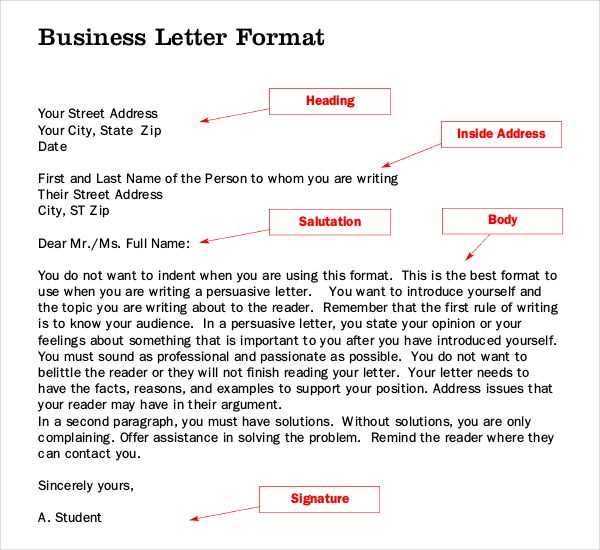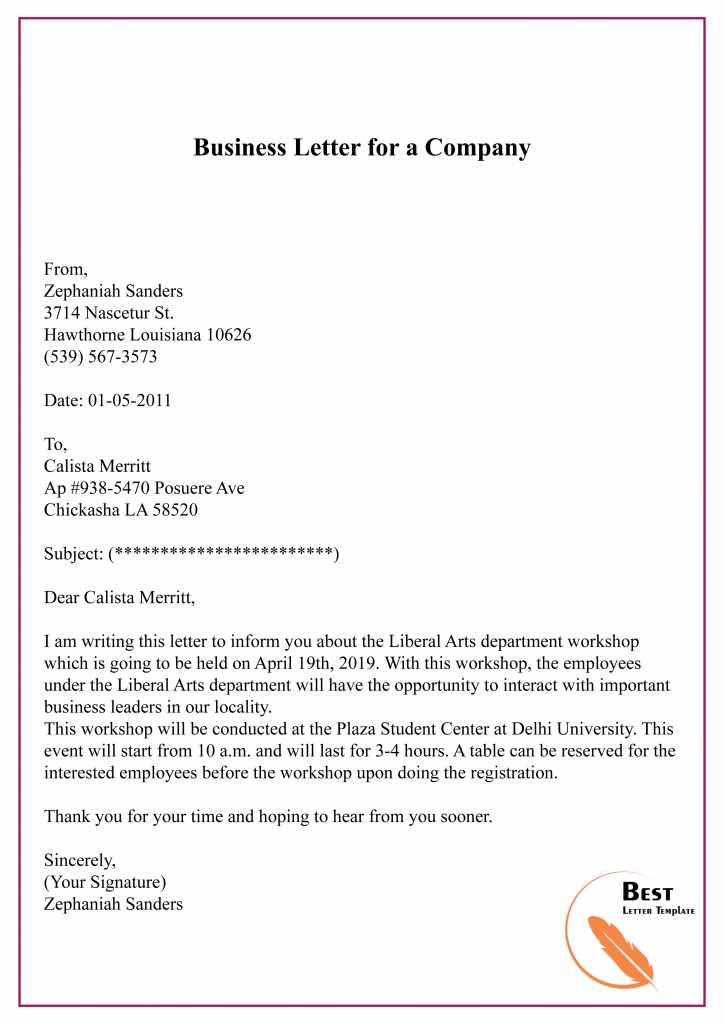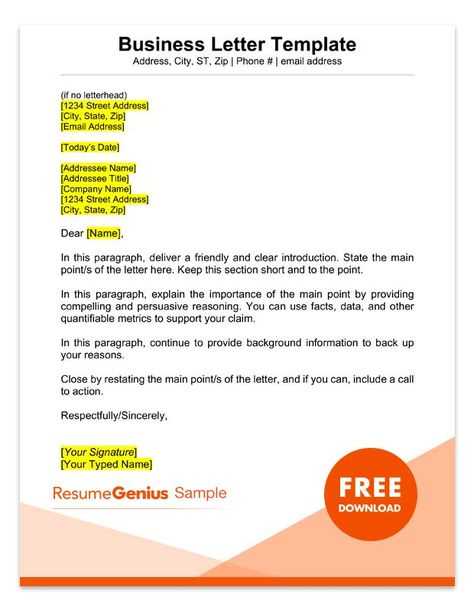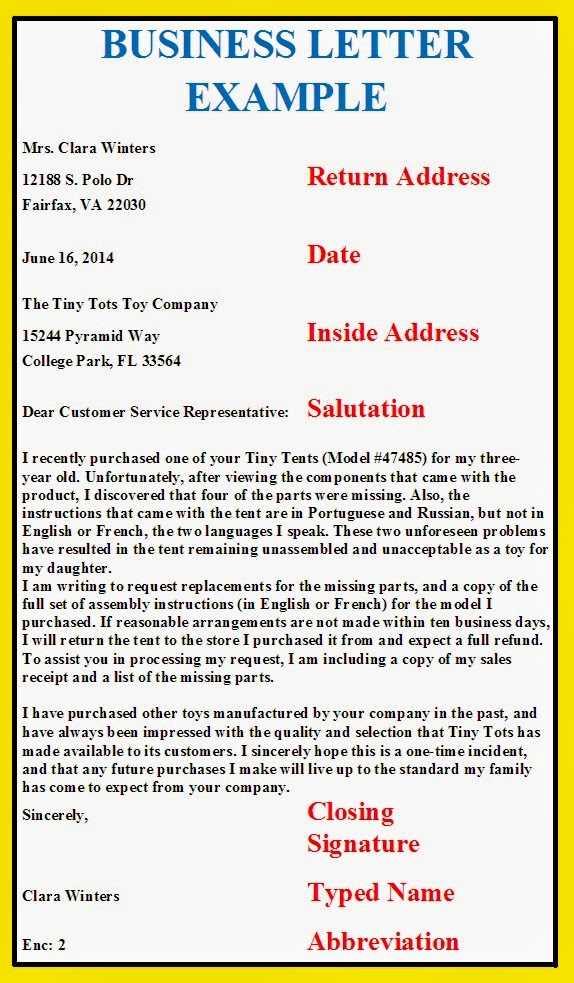Sample Business Letter Template for Effective Communication

Clear and effective communication is essential in many professional settings. Crafting well-structured messages is key to conveying information with clarity and ensuring the intended impact. This section provides guidance on how to create an organized and professional written form for various purposes, from formal requests to business proposals.
Key Components of a Formal Communication
When preparing a formal message, several crucial elements must be included to ensure professionalism and clarity. These include the sender’s details, the recipient’s information, the purpose of the message, and a clear call to action. Understanding these components is essential for achieving effective communication.
Sender and Recipient Information

Begin with the full name, title, and address of both the sender and the recipient. This ensures that the communication reaches the correct individual and is properly addressed. Proper formatting helps avoid confusion and adds to the overall formality of the communication.
Purpose of the Communication
Clearly state the main reason for the correspondence in a concise manner. Whether you are making a request, providing information, or proposing an idea, it is essential to express the purpose upfront to guide the recipient’s understanding of the message.
Formatting for Professional Messages
Formatting is critical when crafting formal messages, as it impacts the readability and overall impression of the communication. Ensuring that the text is easy to follow and looks organized enhances the effectiveness of the message.
- Consistent Font and Size: Use a clear and professional font, such as Arial or Times New Roman, with a font size between 10 and 12 for readability.
- Proper Spacing: Use adequate line spacing, typically 1.15 to 1.5, to keep the content from appearing crowded.
- Alignment: Align the text to the left for a clean, uniform appearance.
Closing Remarks and Signature

End your message with a courteous closing and your name. Depending on the context, you may also include your job title, company name, or contact information to provide further clarity to the recipient.
Customizing Correspondence for Different Situations
Adapting the format and tone of your communication to the specific situation is essential for effective outcomes. Customization involves adjusting the level of formality, the type of language, and the structure based on the purpose and audience.
- Formal Requests: When making a formal request, it is important to be polite and direct. Use phrases like “I respectfully request” or “I would appreciate it if” to maintain professionalism.
- Proposals and Offers: Proposals often require a more persuasive tone. Be clear about the benefits and details of your offer, while remaining courteous and respectful.
Common Errors to Avoid
Even minor mistakes can detract from the professionalism of your communication. It is essential to proofread and revise the content to avoid errors in spelling, grammar, or formatting that could weaken your message. Additionally, ensure that the message is clear and concise, without unnecessary details that might confuse the recipient.
By following these guidelines, you can create professional written communications that are effective and well-received, ensuring clarity, professionalism, and the desired outcome.
How to Write a Professional Communication
Effective written communication is a crucial skill in any professional environment. The ability to convey ideas clearly and formally can make a significant impact on the outcome of interactions. This section explores the key steps involved in crafting a structured and polished written message that can serve various professional purposes.
Understanding the Importance of Structure

A well-organized message not only makes it easier for the reader to understand but also enhances the credibility of the sender. Proper structure ensures that the purpose of the communication is clear from the start and that all necessary details are included in an easily digestible format. Without structure, messages can become confusing or overlooked.
Key Components of Formal Communication
In every formal communication, several essential elements must be included to make it complete and professional. These include a clear introduction stating the purpose, the body that presents the relevant information or request, and a closing that summarizes the main points and outlines any follow-up actions. Each component should be thoughtfully crafted to maintain professionalism.
By incorporating these components and maintaining a consistent structure, you create a polished communication piece that increases the chances of a positive response from your recipient.
Formatting Tips for Effective Communication
Proper formatting is integral to ensuring your message is readable and easy to follow. Use a standard, professional font and ensure the text is aligned neatly. Keep margins consistent and avoid dense blocks of text by using proper paragraph spacing. Bullet points or numbered lists can be helpful when organizing information, allowing readers to digest key points quickly.
Customizing Written Messages for Various Situations
Not every message requires the same approach. Customizing your communication to fit the specific context can make your correspondence more relevant and effective. Whether you’re making a formal request, providing an update, or addressing a problem, adjusting the tone and language is essential. Tailoring your approach helps ensure your message resonates with the reader and serves its intended purpose.
Personalizing templates for your specific needs is a simple yet effective way to streamline communication without sacrificing quality or professionalism.
Common Errors in Professional Communication
Even small mistakes can undermine the professionalism of your message. Common errors include incorrect punctuation, grammar mistakes, and misalignment of information. Always proofread your content before sending it to catch any mistakes that may reduce the clarity or impact of your message.
How to Avoid Pitfalls in Writing
To avoid common pitfalls, focus on clarity and brevity. Avoid jargon or overly complicated language that may confuse the reader. Be direct and to the point, ensuring that your message serves its purpose efficiently. Additionally, always ensure your tone matches the context and the recipient, whether formal or more conversational, to maintain professionalism.